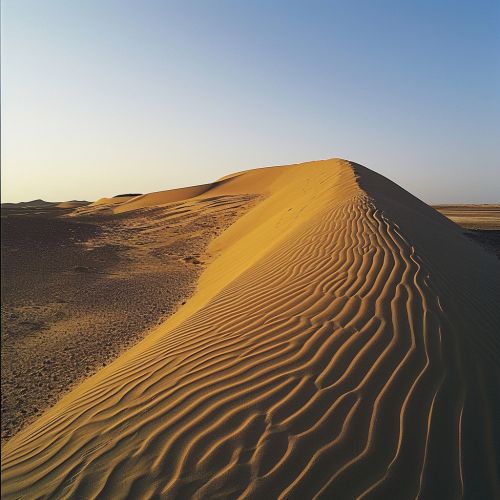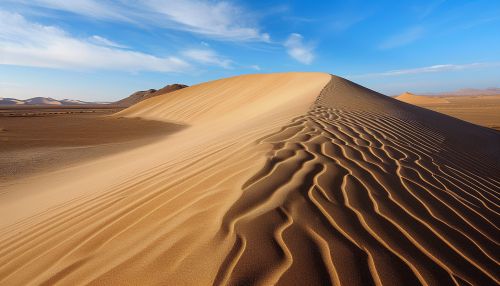Barchan
Introduction
A Barchan or barkhan dune is a crescent-shaped dune that forms in desert or coastal environments. The term was introduced in the scientific literature by Russian naturalist Alexander von Middendorf in 1881 for crescent-shaped sand dunes in the deserts of Turkistan and other places in Central Asia. The word barchan is Kazakh for a "sand hill".
Formation
Barchans are formed by the action of wind, typically blowing from one direction. The wind blows sand up the shallower slope of the dune, known as the stoss side, and deposits it on the steeper, downwind slip face. When the wind blows sand beyond the crest of the dune, it cascades down the slip face. The sand is then compacted and, over time, forms a hard, protective layer that shields the interior of the dune from further changes.


Characteristics
Barchans usually occur as groups of individual dunes and might form chains that extend across a plain in a crescentic wave. The horns or arms of the barchan point downwind and are made of finer, well-sorted sand particles. The bulk of the sand is located at the dune's apex, which migrates downwind, leading the way, while the horns, composed of coarser particles, lag behind.
Migration
Barchans are mobile and move with the wind, the speed of their movement depending on the wind speed and the availability of sand. In some cases, barchans can migrate several meters per year. When two barchan dunes collide, they can merge into a larger dune, or a smaller dune can be absorbed by a larger one.
Variations
There are several variations of barchan dunes, including barchanoid ridges, transverse dunes, and compound and complex barchan dunes. Barchanoid ridges are similar to barchans but occur in a linear rather than crescent shape. Transverse dunes are a larger version of barchanoid ridges and form a series of linear dunes perpendicular to the wind direction. Compound and complex barchan dunes are larger dune structures composed of many individual barchan or barchanoid dunes.
Distribution
Barchan dunes are found in many desert environments around the world, including the Sahara Desert in Africa, the Arabian Peninsula, the Gobi Desert in Mongolia, and the Great Sandy Desert in Australia. They are also found in coastal areas where steady winds blow inland from the ocean, such as the Namib Desert in Namibia and the coastal dunes of Brazil.
Impact on Human Activity
Barchan dunes can have both positive and negative impacts on human activities. On the positive side, the movement of barchan dunes can reveal buried archaeological sites and artifacts. On the negative side, the migration of dunes can pose a threat to human settlements and infrastructure, such as roads and railways.
